Automatic Spice Dispenser
Senior Design Project, 2018
This project was our Senior Design Capstone Project. The objective was to conceptualize, design, and prototype a consumer product which incorporated electromechanical elements. Our group decided to create an automated spice dispenser which could dispense spices in measured amounts. The project was completed over the course of 2 quarters (about 22 weeks) with a team of 7 members. I was one of the main CAD designers. I also designed and assembled the majority of our electronics. Additionally, I rendered the visualized projects as well as prepared designs for manufacture.
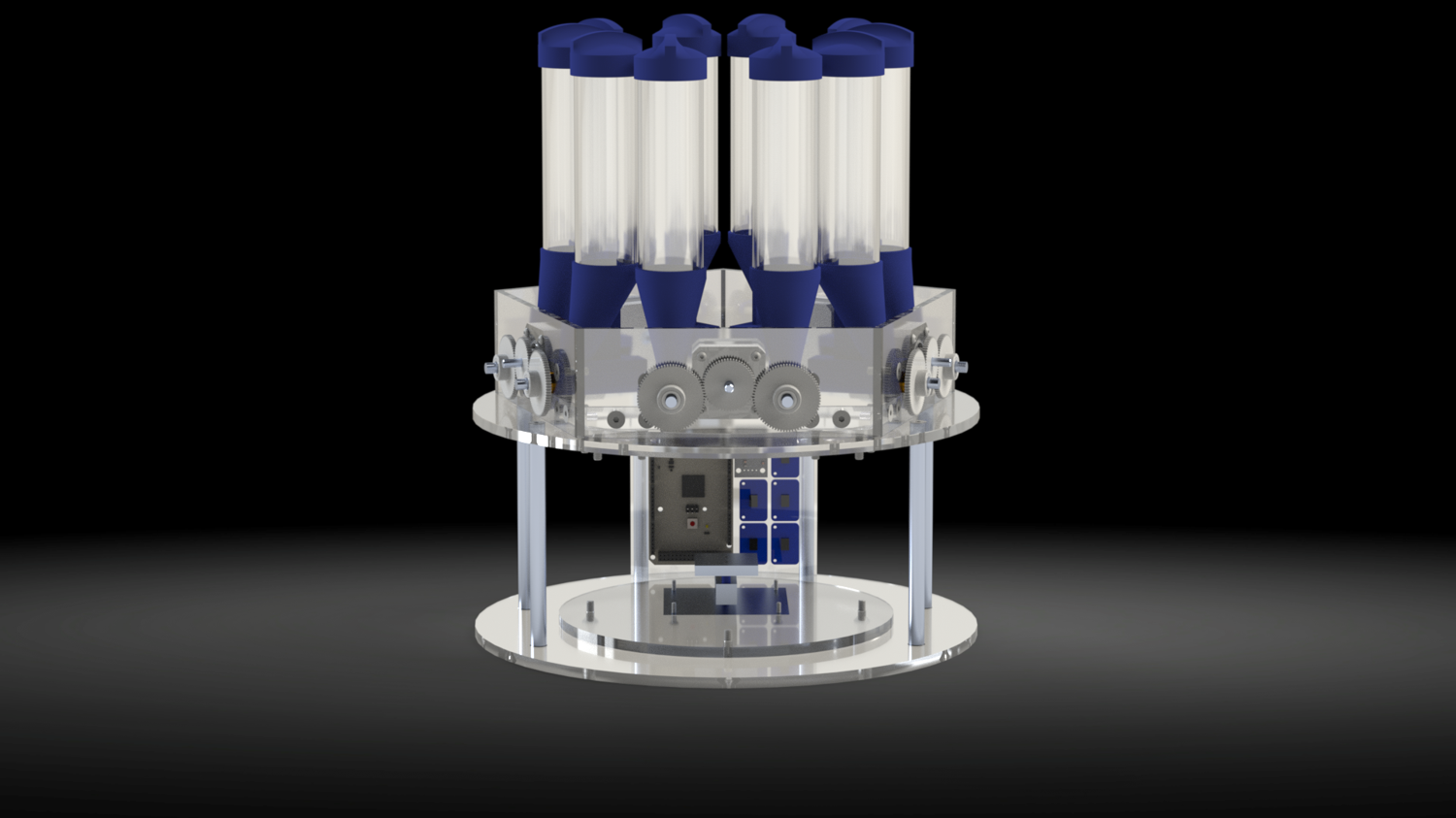
Design Considerations
The main design objectives were to create a product which could accurately and quickly dispense spices, in addition to creating an aesthetic design. The product must be easy to use and also be reliable enough to avoid issues such as feeder jamming or poor spice dispensing. Additionally, there should be no possibility of cross-contamination of spices (no residue left over after dispensing).
The engineering considerations were budget (we were given a limited protoyping budget), manufacturability (due to limited manufacturing resources available), ease of assembly and robustness/reliability. Our project objectives were as follows:
- Main Goal
- Create device that dispenses spices accurately and quickly
- Total spice-dispensing time of 10 seconds
- Accurate to within a tenth of a gram
- Capability to pre-program spice mixes
- Create device that dispenses spices accurately and quickly
- Secondary Goals
- Low level spice warning
- Manual spice dispensing
- User interface
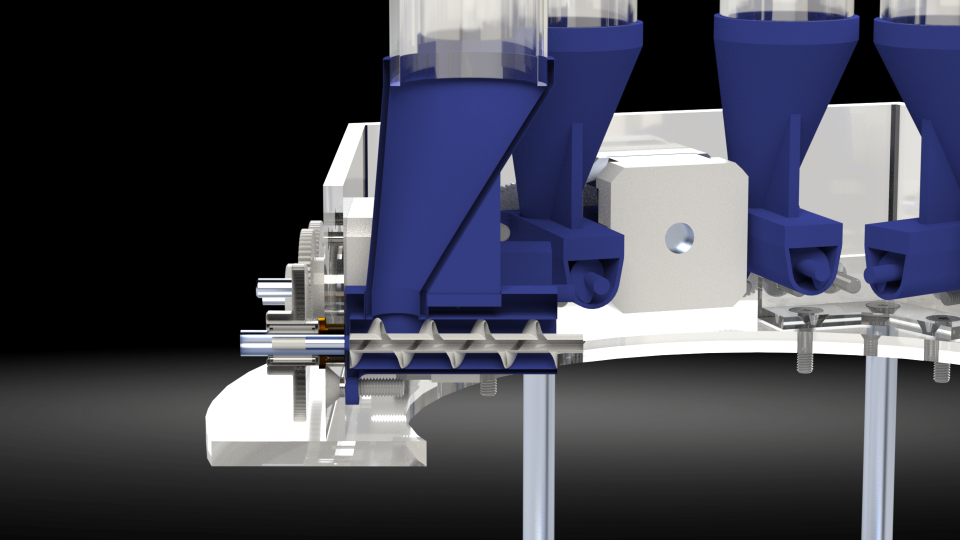
Due to the limitations of budget and manufacturability, we aimed to use as few unique parts as possible. This included standardizing fasteners, as well as utilizing a design with as much modularity as possible. Although some parts are left and right-handed, these parts still for the most part interface with standard parts. Additionally, to minimize costs and time, we designed our parts to be manufactured primarily by rapid prototyping techniques such as lasercutting and 3D printing. These techniques allowed us to reduce our reliance on purchased parts as well as provide custom parts at low cost (thanks to our on campus resources). Where strength was required, we did utilize some manually machined pieces, but left these as simple as possible to reduce time spent in manufacturing as well as reduce chances of errors during manufacturing.
Design Process
The first step was to identify all the components necessary to complete our design objectives. These included a mechanical system to feed the spice, a container to store the spice, a way to control the amount of spice dispensed, as well as an integration of the electronics. We considered many different ideas, including have a single feed system and a selecter system to load a “cartridge” of spice. We also considered using individually actuated feeder mechanisms with one motor per spice. We ultimately decided that using one feeder mechanism may increase the likelihood of cross-contamination, as nobody wants a bit of cinammon when they are dispensing salt. We also were to determined to limit the costs of electromechanical components, and stepper motors are comparitively expensive to the rest of the design elements. Below shows our CAD model for the motor assembly, a solution which combines the dispensing of two spices into a single unit with one motor. To minimize costs and electronic complexity, we used one way bearings, combined with left-hand and right-hand versions of assemblies to utilize one stepper motor to drive two different feeder mechanisms.
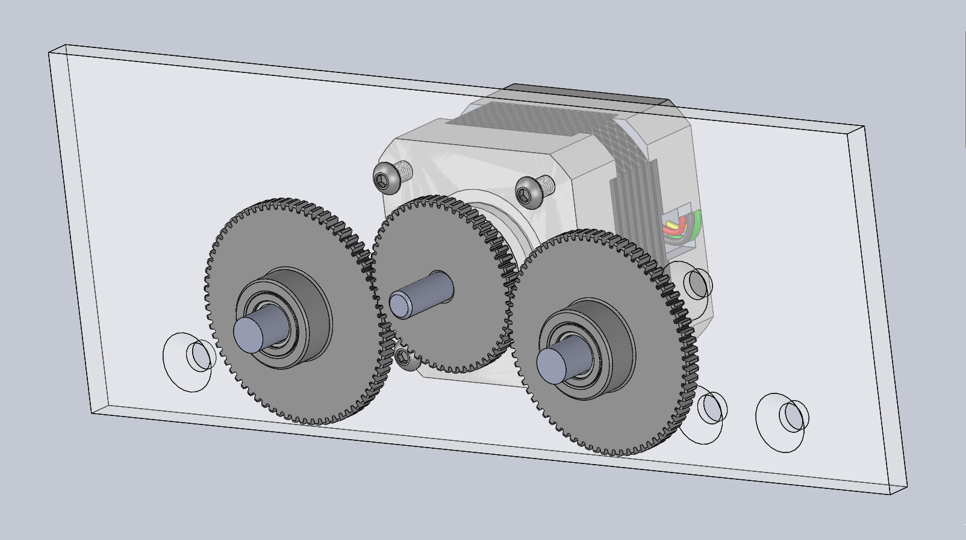 These one-way bearings allow the auger to turn in one direction to dispense spice, while slipping when the motor is turned the other direction. Following the completion of the full CAD model of our design, we moved on to small-scale prototyping. A test run of our motor mechanism is shown below. Notice how the augers only rotate in one direction thanks to the one-way bearings.
These one-way bearings allow the auger to turn in one direction to dispense spice, while slipping when the motor is turned the other direction. Following the completion of the full CAD model of our design, we moved on to small-scale prototyping. A test run of our motor mechanism is shown below. Notice how the augers only rotate in one direction thanks to the one-way bearings.
Iterative Design
Following the completion of our initial prototype, we took steps to improve our product. We noticed several issues which needed to be improved on:
- Some spices flowed poorly.
- Elements would move when stepper motors were activated
- Gears would sometimes becomes misaligned when stepper motors were activated
We addressed these in the following ways:
- Added vibration motors housed internally within the hopper to agitate spices.
- Added another plate to add extra support / further constrain elements.
- Designed and laser cut additional backplate to gear axles.
Below, is shown the additional motor bracket designed to constrain the feeder axles:
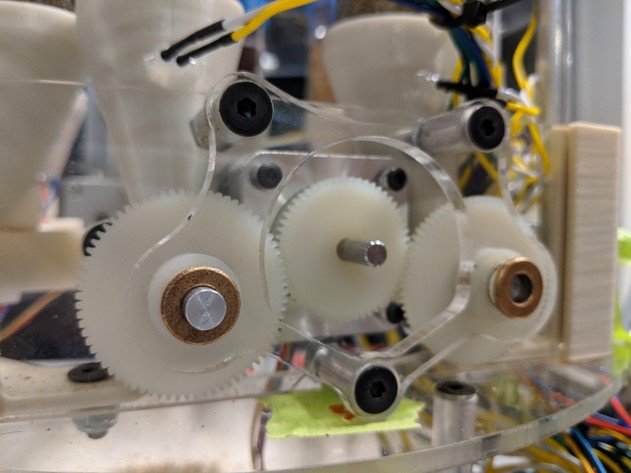 We also improved in other areas, redoing a mounting bracket to decrease assembly time, as well as revising dispensing items such as the feeder trough and the auger design to enhance the spice delivery. We also started to implement our stretch goals, such as manual spice actuation, as well as low spice detection.
We also improved in other areas, redoing a mounting bracket to decrease assembly time, as well as revising dispensing items such as the feeder trough and the auger design to enhance the spice delivery. We also started to implement our stretch goals, such as manual spice actuation, as well as low spice detection.
Electronics Specifications
I was the main person responsible for the electronics and software integration. To accomplish these I utilized a wide range of sensors and other IC boards. The main driving factor for these parts were cost and ease of use. Electronics comprised a major part of our budget, and we could not manufacture these in house to reduce costs. Below, you can see the visible button for the manual dispensing, as well as the leads for the vibration motor which is embedded in the hopper (off-white color).
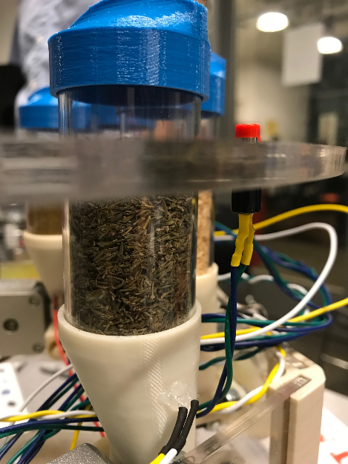 To provide the processing power, we used an Arduino Pro Mini. This was chosen due to our familiarity with the Arduino programming environment, the low cost, and ease of use. We paired the Pro Mini with several I/O multiplexers as well as 2 ADCs, all of which communicated via I^2C to our main board. The multiplexers were necessary given the large amount of outputs needed to control our motors and large number of inputs from our sensors. Below shows a schematic for our electronics. Given the nature of our project as a Mechanical Engineering capstone, this was hand-drawn for time efficiency as it would take longer for me to complete a digital schematic. (Ultimately the electronics are secondary in importance for the evaluation of our mechanical engineering skills.)
To provide the processing power, we used an Arduino Pro Mini. This was chosen due to our familiarity with the Arduino programming environment, the low cost, and ease of use. We paired the Pro Mini with several I/O multiplexers as well as 2 ADCs, all of which communicated via I^2C to our main board. The multiplexers were necessary given the large amount of outputs needed to control our motors and large number of inputs from our sensors. Below shows a schematic for our electronics. Given the nature of our project as a Mechanical Engineering capstone, this was hand-drawn for time efficiency as it would take longer for me to complete a digital schematic. (Ultimately the electronics are secondary in importance for the evaluation of our mechanical engineering skills.)
 Here are some specifications for our various electronic systems:
Here are some specifications for our various electronic systems:
- Microcontroller and I/O Boards
- Arduino Pro Mini, 3.3V, 8MHz, interfaced with FTDI header to serial
- 12 Digital I/O pins, 6 Analog pins
- Selected due to small package size, 3.3V voltage
- 3x SparkFun 16 Output I/O Expander Breakout - SX1509
- Communicates Over I2C - 48 total pins available
- Different addresses on each I/O board
- 1x ADS1115 ADC
- Adds 4 Analog pins over I2C
- 1x HX711 ADC
- Used for Weight Sensor
- Arduino Pro Mini, 3.3V, 8MHz, interfaced with FTDI header to serial
- Motors
- 5x NEMA-17 Bipolar Stepper motors
- 5x Adafruit TB6612 Motor Driver IC boards
- Powered off 12v 4Amp AC/DC Converter
- 10x C0720B015F Vibration Motor
- Used to agitate spice to ensure smooth flow
- Powered by 3.3V power supply, 10000 RPM
- Sensors and User Inputs
- 10x Photoresistors used for low spice detection
- 1MOhm + when dark, 10kOhm when under room light
- Connect to ADC / analog input
- Check voltage against cutoff voltage, under low spice condition photoresistor will decrease in resistance
- 10x buttons for manual dispensing
- Normally closed, connected to 10k pulldown resistor
- Connected to Digital I/O pin
- Serial input from computer
- Allows dispensing according to recipes stored on computer
- Connected with USB via FTDI header
- Load cell
- Paired with HX711 ADC, a 24 bit ADC to convert analog signal to discrete signal
- 10x Photoresistors used for low spice detection
Summary and Conclusions
We achieved all of our goals, and produced a functional prototype which accurately and quickly dispensed a variety of spices. We also fulfilled our secondary goals of low spice level detection and manual spice dispensing. We did have some issues with a large amount of wires–in the future greater foresight is needed for cable management. The large amount of electronic components combined with the need for a large amount of wires to connect these systems resulted in a bit of a rats nest which hampered troubleshooting. In the future, a PCB would help reduce interboard connection wires. I would also look into better wiring practicies using connectors and ribbon wire. Additionally, we found that spices can still clump, which reduces the effectiveness of our dispensing. Ultimately, we achieved our design goals and created a good working design, but further improvements would be necessary before the product could go to market.